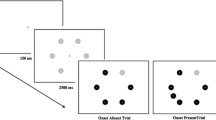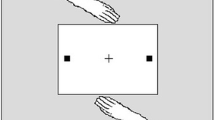Abstract
Two experiments employed a game context to examine the effects of positive and negative feedback on the processing of targets varying in incentive properties. While half the targets carried no value, the others were assigned either a positive incentive value (where points could be gained) or a negative value (where points could be lost), and either a large incentive size (worth 5 points) or a small size (worth 2 points). Feedback from the previous trial was found to exert three effects on subsequent targets. A congruent effect appeared in the faster processing of large targets that matched the positive or negative valence of the previous feedback signal. An incongruent effect was evident in the delays in shifting attention from pretarget cues that contrasted in valence to the previous feedback. A focusing effect was reflected in the general delays following negative feedback in responding to targets with no value. In addition to these outcome influences, processing was generally more efficient for targets carrying positive than negative incentive value, and for targets of large than small size. These findings are discussed in terms of contemporary models of motivation and information processing.
Similar content being viewed by others
References
Bacon, S. J. (1974). Arousal and the range of cue utilization.Journal of Experimental Psychology, 102 81–87.
Blaney, P. H. (1986). Affect and memory: A review.Psychological Bulletin, 99 229–246.
Bower, G. H. (1981). Mood and memory.American Psychologist, 36 129–148.
Brandt, J. L., Derryberry, D., & Reed, M A. (1992).Failure and attentional narrowing. Unpublished manuscript.
Derryberry, D. (1988). Emotional influences on evaluative judgments: Roles of arousal, attention, and spreading activation.Motivation and Emotion, 12 23–55.
Derryberry, D. (1989). Effects of goal-related motivational states on the spatial orienting of attention.Acta Psychologica, 72 199–220.
Derryberry, D. (1991). The immediate effects of positive and negative feedback signals.Journal of Personality and Social Psychology, 61 267–278.
Derryberry, D., & Reed, M. A. (1993).Attentional components of temperament: Orienting toward and away from positive and negative signals. Manuscript submitted for publication.
Derryberry, D., & Tucker, D. M. (1991). The adaptive base of the neural hierarchy: Elementary motivational controls on network function. In R. Dienstbier (Ed.),Nebraska Symposium on Motivation (Vol. 26, pp. 289–342). Lincoln: University of Nebraska Press.
Derryberry, D., & Tucker, D. M. (in press). Motivating the focus of attention. In P. Niedenthal & S. Kitayama (Eds.),The heart's eye: Emotional influences in perception and attention. San Diego, CA: Academic Press.
Easterbrook, J. A. (1959). The effect of emotion on cue utilization and the organization of behaviour.Psychological Review, 66 183–201.
Eriksen, C. W., & Yeh, Y. (1985). Allocation of attention in the visual field.Journal of Experimental Psychology: Human Perception and Performance, 11 583–597.
Grossberg, S., & Schmajuk, H. A. (1987). Neural dynamics of attentionally modulated Pavlovian conditioning: Conditioned reinforcement, inhibition, and opponent processing.Psychobiology, 15 195–240.
Hockey, R. (1979). Stress and the cognitive components of skilled performance. In V. Hamilton & D. M. Warburton (Eds.),Human stress and cognition: An information processing approach (pp. 141–177). New York: Wiley.
Hope, D. A., Rapee, R. M., Heimberg, R. G., & Dombeck, M. J. (1990). Representations of the self in social phobia: Vulnerability to social threat.Cognitive Therapy and Research, 14 177–190.
Isen, A. M., & Daubman, K. A. (1984). The influence of affect on categorization.Journal of Personality and Social Psychology, 47 1206–1217.
Isen, A. M., & Geva, N. (1987). The influence of positive affect on acceptable level of risk and thoughts about losing: The person with a large canoe has a large worry.Organizational Behavior and Human Decision Processes, 39 145–154.
Isen, A. M., Johnson, M., Mertz, E., & Robinson, G. (1985). The influence of positive affect on the unusualness of word associations.Journal of Personality and Social Psychology, 48 1413–1426.
Isen, A. M., Nygren, T. E., & Ashby, F. G. (1988). Influence of positive affect on the subjective utility of gains and losses: It is just not worth the risk.Journal of Personality and Social Psychology, 55 710–717.
Isen, A. M., Rosenzweig, A. S., & Young, M. J. (1991). The influence of positive affect on clinical problem solving.Medical Decision Making, 11 221–227.
Johnson, E., & Tversky, A. (1983). Affect, generalization, and the perception of risk.Journal of Personality and Social Psychology, 45 20–31.
Kahneman, D., & Tversky, A. (1979). Prospect theory: An analysis of decisions under risk.Econometrika, 47 263–291.
La Berge, D., Tweedy, J. R., & Ricker, J. (1967). Selective attention: Incentive variables and choice time.Psychonomic Science, 8 341–342.
Loftus, G. R. (1972). Eye fixation and recognition memory for pictures.Cognitive Psychology, 3 525–551.
Mackie, D. M., & Worth, L. T. (1989). Processing deficits and the mediation of positive affect in persuasion.Journal of Personality and Social Psychology, 57 27–40.
MacLeod, C., & Mathews, A. (1988). Anxiety and the allocation of attention to threat.Quarterly Journal of Experimental Psychology, 40 653–670.
Manstead, A. S. R., Wagner, H. L., & MacDonald, C. J. (1983). A contrast effect in judgments of emotional state.Motivation and Emotion, 7 279–290.
Mathews, A. (1990). Why worry? The cognitive function of anxiety.Behavioural Research and Therapy, 28 455–468.
Maitlin, M. W., & Stang, D. J. (1978).The pollyanna principle: Selectivity in language, memory, and thought. Cambridge, MA: Schenkman.
Mikulincer, M., Kedem, P., & Paz, D. (1990). Anxiety and categorization—1. The structure and boundaries of mental categories.Personality and Individual Differences, 11 805–814.
Mischel, W., Ebbesen, E., & Zeiss, A. (1976). Determinants of selective memory about the self.Journal of Consulting and Clinical Psychology, 44 92–103.
Nygren, T. E., & Isen, A. M. (1985).Examining probability estimation: Evidence for dual subjective probability functions. Paper presented at the Meeting of the Psychonomic Society, Boston, MA.
Posner, M. I. (1978).Chronometric explorations of mind. Hillsdale, NJ: Erlbaum.
Posner, M. I., Inhoff, A. W., Friedrich, F. J., & Cohen, A. (1987). Isolating attentional systems: A cognitive-anatomical analysis.Psychobiology, 15 107–121.
Postman, L., & Brown, D. R. (1952). The perceptual consequences of success and failure.Journal of Abnormal and Social Psychology, 47 213–227.
Pratto, F., & John, O. P. (1991). Automatic vigilance: The attention-grabbing power of negative social information.Journal of Personality and Social Psychology, 61 380–391.
Rinck, M., Glowalla, U., & Schneider, K. (1992). Mood-congruent and mood-incongruent learning.Memory and Cognition, 20 29–39.
Rothbart, M. K., & Derryberry, D. (1981). Development of individual differences in temperament. In M. E. Lamb & A. L. Brown (Eds.),Advances in developmental psychology (Vol. 1, pp. 37–86). Hillsdale, NJ: Erlbaum.
Schneider, W., & Detweiler, M. (1987). A connectionist/control architecture for working memory. In G. H. Bower (Eds.),The psychology of learning and motivation (pp. 54–121). New York: Academic Press.
Shaw, E. D., Mann, J. J., Stokes, P. E., & Manevitz, Z. (1986). Effects of lithium carbonate on associative productivity and idiosyncrasy in bipolar outpatients.American Journal of Psychiatry, 143 1166–1169.
Toates, F. M. (1983). Exploration as a motivational and learning system: A cognitive incentive view. In J. Archer & L. I. A. Birke (Eds.),Exploration in animals and humans (pp. 55–71). Workingham, England: Van Nostrand Reinhold (UK).
Watts, F. N., McKenna, F. T., Sharrock, R., & Trezise, L. (1986). Color naming of phobic-related words.British Journal of Psychology, 77 97–108.
Wise, R. A. (1987). Sensorimotor modulation and the variable action pattern (VAP): Toward a noncircular definition of drive and motivation.Psychobiology, 15 7–20.
Author information
Authors and Affiliations
Rights and permissions
About this article
Cite this article
Derryberry, D. Attentional consequences of outcome-related motivational states: Congruent, incongruent, and focusing effects. Motiv Emot 17, 65–89 (1993). https://doi.org/10.1007/BF00995186
Issue Date:
DOI: https://doi.org/10.1007/BF00995186




